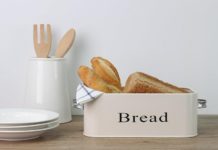The knife has a variety of uses. It is a cooking tool; cutlery for making it; adaptation for solving household problems; to resolve issues arising in field conditions; steel arms.
In terms of functionality, they can be canteens, hunting, tourist, gift, office, interior elements, for drivers, hiking, folding, for tourism, recreation, training, combat, army, for woodworking, fishing, Finnish, Scandinavian, chopping, kitchen ... The editorial staff of the site "Ya Nashla" offers you an overview of the best kitchen knives in 2020.
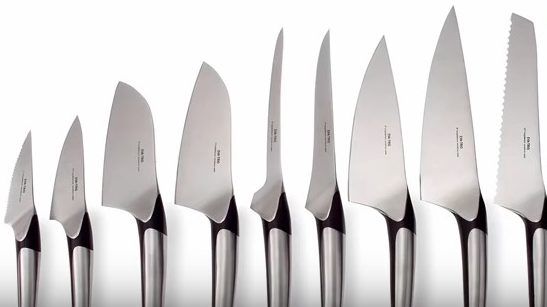
Content
Knives: some facts
In total, European cuisine has about 20 types of knives. Japanese - from 200 to 800, i.e. there is a different type of cutter for each kitchen operation.
If you are not a sophisticated culinary specialist, then one universal will suit you.
If you feel like a culinary wizard transforming food into a work of art, then you will need many tools to make your fantasy come true.
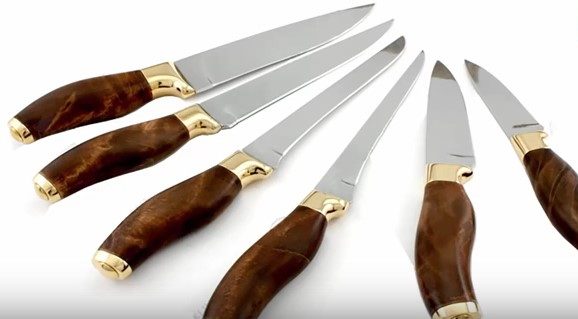
The average home cook will cost 3 to 5 cutting assistants.
The number of additional cutting tools will depend on the personal preferences of each individual culinary specialist: vegetable lovers will do well with a vegetable hatchet, cheese gourmets need a special one for beautiful slicing, who prefer meat or fish fillets - with a plastic, flexible cutter, etc.
Let's look at the general points to pay attention to when choosing.
general review
The functionality of the knife can be different, involving several operations: cutting, cleaning, cutting the product. Based on this, kitchen knives are distinguished for:
- of bread;
- meat or fish fillets;
- cheese;
- oils;
- vegetables;
- cleaning vegetables, fruits;
- cutting meat;
- product surface carvings;
- to create a beautiful appearance.
The size
Will depend on the planned function of the future purchase:
- large, in the form of a hatchet (for cutting, cutting);
- chef's knife with a flat, wide blade, from 15 - 30 cm;
- with a long blade (for slicing bread or sushi);
- small (for peeling fruits and vegetables), 10 - 15 cm;
- medium (usually universal), 18 - 22 cm.
Balance and geometry
When choosing, we pay attention to the balance of the handle and the cutting plane, the general geometry of the cutting device.
For chopping it is better if the balance is shifted towards the nose of the knife. For cutting - offset to the handle. For universal ones - at the junction of the blade with the handle.
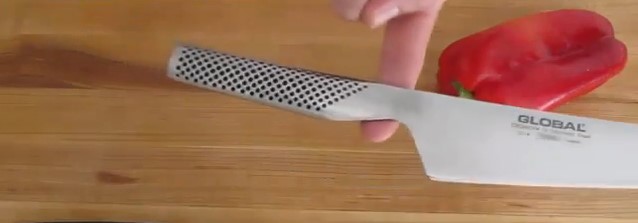
Geometry includes:
- shape;
- corners;
- sharpening;
- descent (transition from the main part of the blade to the edge of the blade).
With the correct geometry, the knife will not push, but cut the product.
Blade
The most important part of a kitchen tool. Its durability and sharpness depend on it. It is made from different types of steel by forging or stamping, ceramics:
- stainless steel;
- carbon steel;
- titanium;
- high carbon stainless steel;
- Damascus steel;
- ceramics.
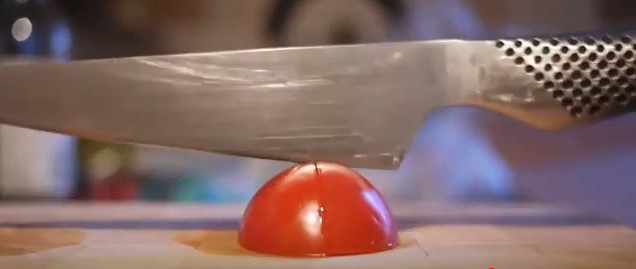
Sharpening can be checked with a piece of paper, a cut on a tomato, or with your finger. The last option is more suitable for professionals, because is traumatic.
If you are faced with a choice, which one is better to buy: steel or ceramic? Let's look at the pros and cons of both.
Steel

Advantages:
- shockproof;
- practical;
- heavy;
- anti-corrosion.
Disadvantages:
- does not cut thinly;
- does not cut fillets evenly;
- may crush the product;
- absorbs odors.
Ceramic

Advantages:
- acute;
- does not absorb odors;
- keeps sharpening.
Disadvantages:
- splits when dropped;
- Do not use on bones and frozen, solid foods.
Output:
The best option would be to purchase steel and ceramic knives and combine them when using.
The form

It can also be different, depending on the function of the cutting device. But in general, it is an arched shape so that it does not rest against a countertop or cutting board.
The thickness of the cutter is preferably 2 to 2.5 mm. If thicker, it will chop, not cut. Thickness from 2.5 mm is suitable for hatchets designed for splitting cartilage and bones.
Blade edge less than 0.5mm. If more, there will be poor product penetration.
The transition from the body to the edge should be smooth.
The harder the steel, the longer it keeps sharpening. 54 - 55 Rockwell units. Lower is not desirable, higher is fragility. The best option is 56 units.
The main part of the blade goes into an additional one, which is fixed with a handle. It is more practical when they are of the same length. This will protect the product from unexpected breakage.
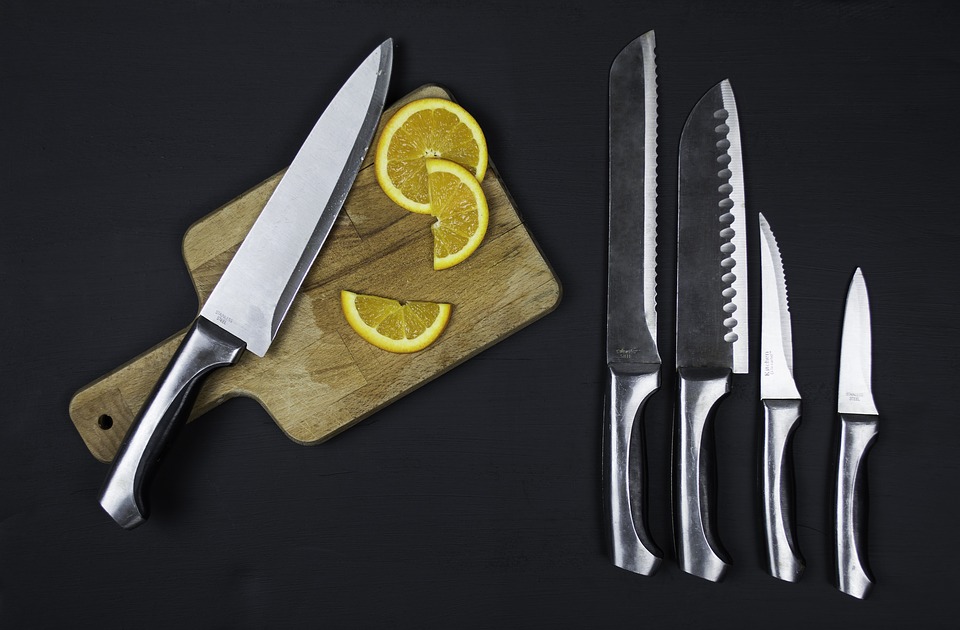
A pen
The ease of use of the tool depends on the shape of the handle. It can be done:
- made of wood - a warm, environmentally friendly material, but not hygienic, not waterproof and requiring careful maintenance.
- Made of metal - a beautiful but cold and sliding material. A comfortable shape is achieved due to the larger size. And this is already excess weight, which will be felt during prolonged work.
- Plastic is perhaps the best choice. Not expensive, not slippery in hand, pleasant to the touch. Not picky about care, practical, moisture resistant.
- Silicone is a modern material that is gaining popularity.
- Combined - steel with wood and plastic inserts.
The style of the handle can be different:
- European;
- Japanese;
- standard;
- ergonomic (hand-shaped).
Situated above the edge of the blade, comfortably in the hand, with room for the index finger to prevent slipping, these are the priority points when determining the suitable grip.
Sharpening
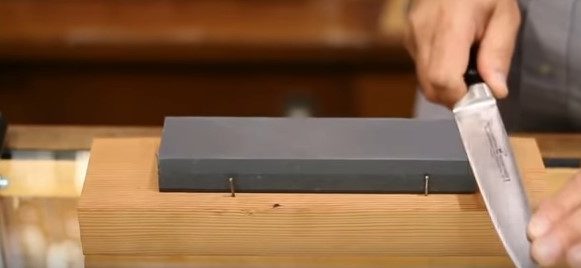
This implies a long service life, removing the least amount of steel. There are various ways to keep your kitchen tool in good working order:
- with the help of paid specialist services;
- in the traditional way - using a bar, a carpentry machine, a grinding wheel.
- modern - with the help of an electric knife, Japanese water stones, a special manual sharpener, a special machine.
For more expensive types of kitchen knives, a thorough, professional sharpening is recommended. With simple views, there is usually much less difficulty.
It must be borne in mind that
the use of plastic and glass cutting boards will dull the blade prematurely.
Don't fall for the cheapness of plastic and the beauty of glass, use eco-friendly, wooden chopping tools.
How to use
The most important thing to use is to use the tool as intended. Then the service life of the food cutter will be longer. Do not use a ceramic knife to cut bones or frozen food - it will inevitably be chipped.
Do not use a bread knife to cut the cheese - it will stick to the cutting surface, and the quality of the slice will leave much to be desired. Do not cut frozen food with it, although it looks so much like a freezer knife.
A universal kitchen cutter does not solve household issues. From this, its deformation can occur, and simply a violation of hygiene and sanitary standards will lead to health problems.
How to care
Kitchen tools when interacting with acids, salts, liquids, etc., are subject to surface oxidation and corrosion.
After use, it is necessary to immediately cleanse of all adhering food debris, rinse under running water. Wipe dry with a napkin or tea towel.
Knives are not dishwasher safe
If the knife is collapsible, then it is periodically laid out in parts, followed by cleaning and lubricating the parts.
If the handle is made of natural material, then treatment with a special care product will be required.
You need to store knives strictly in a specially designated place, a stand, on a magnetic strip. Separated from each other, not a bunch.
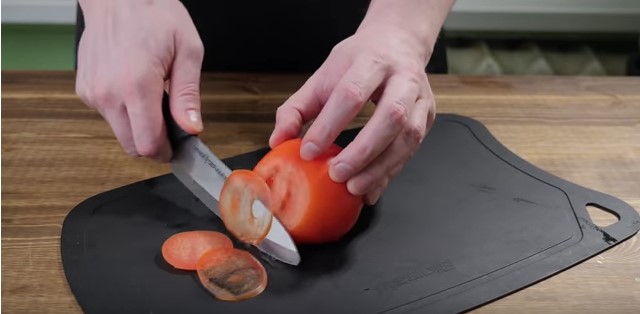
Output:
A good knife is a sharp, long-lasting sharpener, made of the right steel, with the right processing and a comfortable grip.
In this case, he will easily cut food and will serve for a long time, which is what any owner strives for when choosing this kitchen item.
How to choose what to look for
When choosing a steel cutter, it is better to choose one with an “X” on the blade, which means increased anti-corrosion properties, more durable, and longer sharpening. They are made from high carbon alloy steel with added vanadium and molybdenum.
Made of sheet iron, they will quickly become blunt and deformed.
The highest quality ceramic ones - not with white, but with dark blades. They have withstood a longer period of hardening, therefore they are stronger, sharper, do not require constant sharpening. They are made from zirconium carbide.
Dishonest manufacturers can offer counterfeits, passing off as Damascus steel products. A surface laminated under Damascus will not cost you cheap, but it will not justify itself in practical terms.
Selection errors
Common buying mistakes can be:
- pursuit of a promoted brand. May result in unnecessary overpayment. When, with proper monitoring of the knife market, you can find the right one, saving a significant part of the budget.
- denial of the Chinese knife market. There are a sufficient number of reputable brands from China that have a decent product quality.
- focus only on price. May lead to disappointment in quality that does not match the stated price.
- choice by metal hardness. The higher the hardness of the metal (60 - 62 points according to Rockwell), the more easily the edge of the blade crumbles without the possibility of its restoration. With an optimal value of 56 - 57 points according to Rockwell, sharpening the tool will be easy.
- looking for a super steel blade. Unjustified waste of time searching, because the special kind of steel is not vital in the home kitchen. Rather, it is necessary for professional chefs.
- prioritizing beauty or design. It can lead to the uselessness of the cutting device and the possibility of using it in the future only as an art object, if the other important characteristics are not supported in this form. Convenience, practicality and durability in this matter are preferable.
Where can I buy
You can buy high-quality cutting knives at:
- branded knife stores;
- on various sites, incl. Aliexpress;
- on the websites of foreign online stores;
- from the masters.
Now that we have a basic understanding of knives, let's get to know each model in more detail.
Universal
This is a tool that will perform many functions and replace a whole set. In a ready-made set, there can be several of them at once, of different sizes. Length from 12.5 cm to 18 cm, width from 2-3 cm, thickness about 2 mm. Usually wedge-shaped. The handle can be wooden, metal, plastic, of various shapes. Because such a model performs a different number of operations, it must be of high quality and not cheap. Then it will last longer and retain its characteristics.
Steel
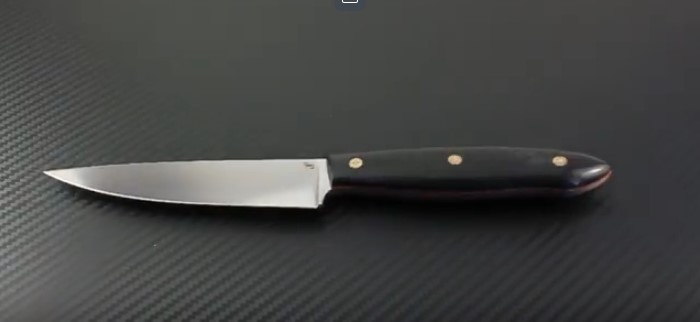
Made from various types of steel:
- stainless;
- forged;
- damask;
- titanium;
- and ceramics.
Steel differs in different carbon content. The lower its value, the softer the cutting plane and the need for its frequent sharpening.
Stainless steel is the best at withstanding corrosion
Titanium is the most flexible, soft, with high wear-resistant characteristics, leaving no metallic taste on the product. Products made from it are quite expensive.
Damascus steel - multilayer, the layers are connected by forging. It has a beautiful weave appearance. Differs in strength and durability, durability, beautiful appearance, sharpness.
Laminated surface
In the production of knives, manufacturers use lamination - covering with a plate of another steel. When combining harder steel with soft grades, this method increases the hardness, wear resistance, and anti-corrosion properties of the cutting surface. The blade is, as it were, sealed into the laminate, reducing the fragility of the edges, the risk of fractures. The product also acquires a beautiful appearance.

Advantages:
- easy sharpening;
- affordability of prices;
- sharpen quickly;
- suitable for solid foods;
- lasting;
- variety of forms.
Disadvantages:
- can leave metallic
- smack on the product;
- some species are oxidized;
- can quickly become blunt;
- rapid wear.
Average price:
- From 54 rub. for a universal kitchen knife, 13 cm long, made by Daniks -
- up to 33,990 rubles, 20 cm long, made by Yaxell.
The best manufacturers according to buyers:
- Samura;
- Rondell;
- Nadoba;
- TimA.
Ceramic
Made from zirconium dioxide by dry pressing. There are two types of product: with a white blade and a dark one. Dark ones undergo a better and longer hardening, therefore their characteristics are higher.

Advantages:
- very sharp;
- do not require sharpening;
- aesthetic;
- beautiful appearance;
- hygienic;
- easy to clean;
- does not oxidize;
- does not rust;
- does not absorb odor;
- easy;
- modern design.
Disadvantages:
- fragile;
- not flexible;
- expensive;
- low impact resistance;
- not suitable for solid foods
average price:
From 115 rub. for a ceramic knife, made in China, with a cover, 7.5 cm long - up to 11 190 rubles. length 18 cm. made by KYOCERA.
Buyer's Best Manufacturer: Bohman.
Santoku
A kind of universal chef's tool. Made of steel. Translated as "3 in 1" - cuts, chops, crumbles. It is convenient to cut various products into cubes, slices, cubes. The standard size is 15 to 20 cm. The wide blade tapering towards the "nose" and the narrow handle give a comfortable palm combination for a variety of kitchen operations. Has a stronger sharpening and withstands cutting of small bones. Good balance of handle and cutter. European models are somewhat different from Japanese ones in other balance, smaller thickness, blade shape.
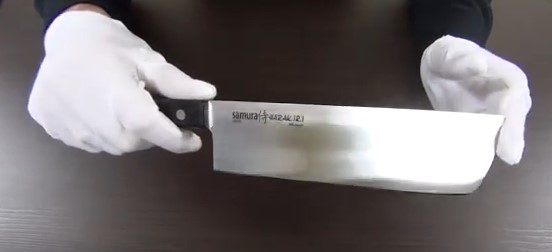
Advantages:
- perfect balance;
- light weight;
- acute;
- keeps sharpening;
- lasting;
- food does not stick to the blade;
- suitable for solid products;
- cuts small bones.
Disadvantages:
- not suitable for cleaning vegetables and fruits;
- not convenient for removing the core from fruits
- or surface defects;
- it is advisable to master the cutting technique;
- not suitable for chopping bones.
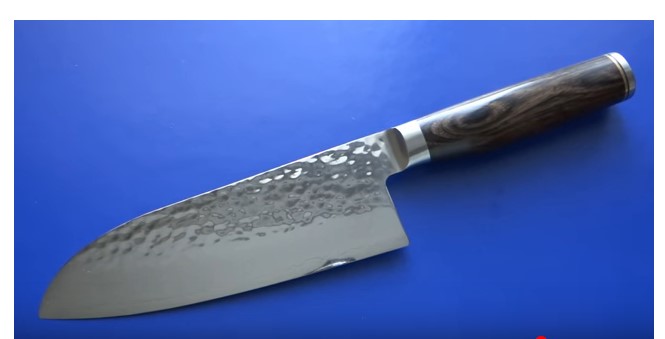
average price:
- From 88 rub. for a santoku knife, 16 cm long, pr-va Attribute -
- Up to 38 680 rubles, 18 cm long, made by Kia.
The best manufacturers according to buyers:
- Samura;
- Rondell.
Chef knife, chef's
This type of kitchen tool can also be classified as universal. Unlike santoku (Japanese chef), it has a smaller size and a blunt edge with a double-sided sharpening beveled to the point. Model standards are:
- German. Heavier, more practical, with a strong butt.
- French. Sleeker, more balanced, thinner butt, suitable for a woman's hand.

The shape of the cutting head allows for an accurate cut using the rocking technique. The center of gravity, shifted to the nose, does not give the arm fatigue during prolonged use.
Its length is from 15-30 cm, the most optimal will be 20-22 cm. Its width also depends on the length of the cutting plane, which proportionally increases with the blade.
It will perfectly cope with slicing, shredding and beating the product with the blunt side of the blade. The wide blade can be used as a spatula to turn food over.
The larger your chef is, the more convenient it is for them to cut food (without fanaticism).
More reliable will be a blade made of forged steel, rolling over the entire length of the handle.
There are ceramic, glass, plastic products. But they are sold less often, because are in less demand.
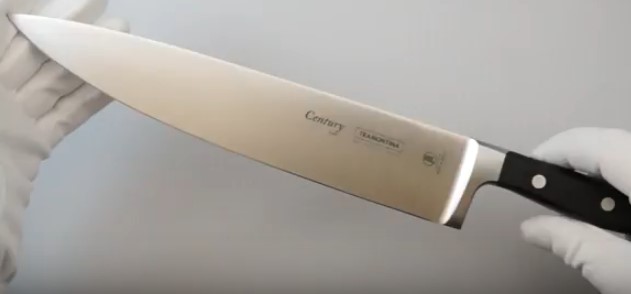
Advantages:
- multifunctional;
- lasting;
- convenient;
- acute;
- keeps sharpening for a long time;
- easy to clean;
- copes with hard
- food and bones.
Disadvantages:
- not suitable for cleaning vegetables and fruits;
- not convenient for removing product defects;
- some species rust.
average price:
- from 95 rubles. for a chef's knife 16 cm long, made by Attribute -
- up to 135,000 rubles, 19 cm long, from Damascus steel, made by Kai.
The best manufacturers according to buyers:
- Samura;
- Rondell;
- CS-Kochsysteme;
- Falkata;
- Diplome.
Special
For vegetables
Convenient, small size. Usually from 7 - 8 cm. To avoid injury due to accidental slipping of the hand onto the blade (due to the small handle), the junction of the blade with the handle is not sharpened.
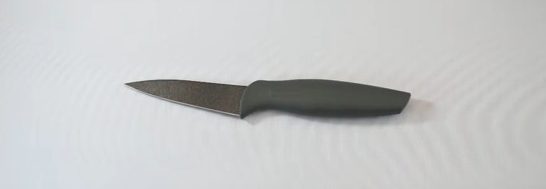
It is indispensable for peeling vegetables and fruits, removing various defects on the surface of the product, as well as extracting the core of some fruits.
With it, you can carry out those kitchen operations that larger models cannot cope with: fine cutting, cleaning hard-to-reach places, economical peeling, beautiful and curly cutting, cutting small products (nuts, garlic), covering mini toasts with butter or sauce.
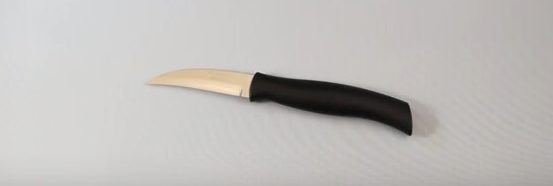
Will help out with large volumes of cleaning (potatoes, onions, carrots, etc.). The shape can be with a different nose:
- sharp. This is a variant of the "fast" tool, since when cleaning with it, you can remove all defects at once.
- rounded. With this shape of the blade, you will have to purchase an additional device to get rid of the eyes, etc. and alternate them at work. This style is not suitable for everyone, and it will take more time.

Advantages:
- small size;
- good for cleaning food;
- convenient;
- practical.
Disadvantages:
- not multifunctional;
- only suitable for cleaning.
average price:
- From 42 rub. for a vegetable knife, 12.5 cm long, made by Tramontina -
- up to 22 350 rubles, length 12 cm, made by Kia.
The best manufacturers according to buyers:
- Nadoba;
- Rondell;
- MAULINvilla;
- Tefal;
- VICTORINOX.
For tomatoes
It is believed that if a knife cuts a tomato, then it is good. And there is a special tool for cutting this vegetable.
It can be classified as vegetable. Made of steel, small size. The shape is slightly curved, with a pointed nose and a bifurcation at the end. The serrated edge of the blade will effortlessly cut through the dense skin and will not crush the vegetable flesh. With this device, you will get even pieces of the desired size. And with a tip you can remove the "ass" of the tomato and pick up the resulting slices.
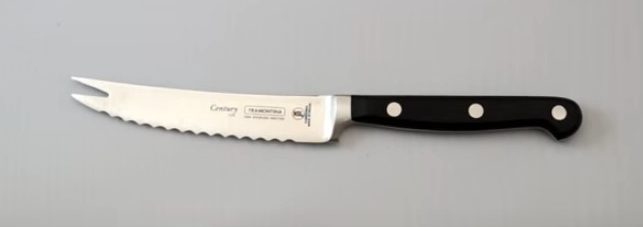
Advantages:
- copes well with cutting this type of product;
- small size;
- suitable for other types of vegetables.
Disadvantages:
- difficulties with sharpening;
- traumatic due to the sharp tip.
average price:
- from 37 rubles. for a knife for tomatoes, 12.7 cm long, made by Appetitte -
- up to 7,590 rubles, 14 cm long, made by Wusthof.
For bread
These knives are special. They were first invented in Germany.
They are distinguished by a special edge sharpening, called serrated. It is similar to a saw blade, but slightly wavy. The method of movement when cutting is sawing.
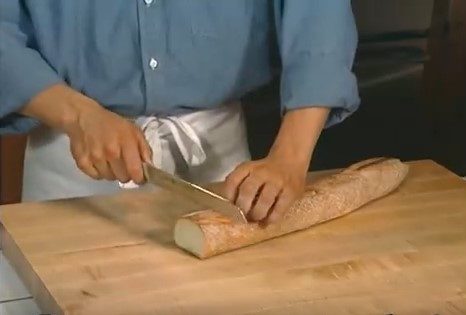
The straight cutting part from 19-23 cm should be longer than the cut product (bread, rolls, loaf). At the end, it has not a point, but a rounded or rectangular part. Has one-sided or two-sided sharpening.
Budget options are made of single-layer steel, more expensive ones are made of Damascus. A hardness in the range of 25-50 Rockwell points will be sufficient.
For greater strength of the tool, a seal is made at the junction of the cutter with the handle. Such knives can be covered with Teflon, polymer, titanium film, which prevents them from sticking.
Ceramic models are not so popular due to their large thickness, which creates inconvenience when cutting baked goods.
Manufacturers have presented interesting models in the form of electric bread knives, wired and wireless, with a simultaneous toaster function, with laser marking.

Advantages:
- keeps sharpening for a long time;
- preserves the structure of the product;
- moisture resistant;
- anti-corrosion.
Disadvantages:
- suitable for only one type of product;
- impossibility of home sharpening.
average price:
- from 91 rub. for a bread knife 20 cm long, pr-va Attribut -
- up to 38 680 rubles, 23 cm long, made by Kai.
The best manufacturers according to buyers:
- Samura;
- Wisthof;
- Arcos.
For cheese
This is a special cutting tool not suitable for other purposes.
Because the cut product (cheese) can have a different consistency, moisture, etc., there is a large number of different devices for grinding each type.
The classic cheese knife has a handle above the blade. The tip has a fork-shaped bifurcation for easy prying of a cheese slice or cube.

For the least contact of the tool with the product and its subsequent adhesion, figured holes are cut out in it.
The working edge of the blade is serrated to facilitate the cutting process by pressing.
The cutting part is made of stainless steel with an antibacterial coating. This is an added bonus to eliminate microbial growth.
The strength of the model is also important for use when cutting hard varieties.
Ceramic varieties are suitable for semi-hard and soft cheeses, but not for hard ones.
For home use, a knife with a size of 8-10 cm is quite suitable.If large volumes of a cheese product are expected, then it is worth purchasing a device 20-24 cm.

Advantages:
- excludes sticking;
- antibacterial coating;
- beautiful cutting;
- anti-corrosion;
- lasting.
Disadvantages:
- suitable only for this type of product.
average price:
- from 114 rubles. for a cheese knife 12.5 cm long, made by Tramantina -
- up to 7 515 rubles, 14 cm long, made in Wusthof.
The best manufacturers according to buyers:
- GiPFELL;
- KitchenAid.
For sushi
If you are not only a lover of rolls and sushi, but even practice their preparation at home, then you cannot do without this cutting tool.
Correctly selected, it will make a beautiful cut drawing, divide it into neat pieces, and facilitate the cooking process.
Various sizes, length from 20 cm to 23 cm, width from 1.8 cm to 3.3 cm. Made of high carbon, stainless steel. Medium weight, as sharp and thin as possible so as not to deform fish fillets. Mainly supplied with wooden handles.
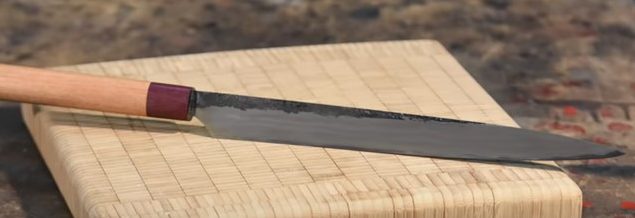
It is preferable to choose a Japanese-made, with a good surface grinding, a thickness of 60 points according to Rockwell. In terms of this quality, they are inferior to French and German blades, having a maximum of 55 points.
Because single-sided sharpening, manufacturers have released rulers for left-handers.
The long, wide cutting plane tapers towards the end in the form of a wedge-shaped point. Suitable for cutting seafood, herbs, fish, seaweed.
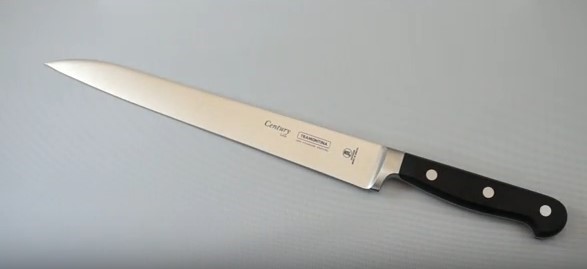
Advantages:
- functional;
- lasting;
- easy to clean;
- anti-corrosion;
- very sharp;
- keeps sharpening.
Disadvantages:
- low wear resistance;
- for lefties, a different model is required.
Buyer's Best Manufacturer: Samura
Sirloin
Suitable for everyone who likes to pamper themselves with fish, meat or chicken fillets.
Long, thin, elongated, flexible blades, raised towards the end. This allows you to separate the meat from the bone or skin and get even, neat pieces that do not stick to the surface.
The length can be chosen according to your preference from 10 cm to 35 cm. It should be twice the length of the cut itself. The best option would be a length of about 19 cm.
The blade is much smaller than the handle, with a special stop for the index finger. Beautiful models are made of Damascus steel, but their disadvantage is low corrosion resistance.
There are also electric and folding fillet tools.
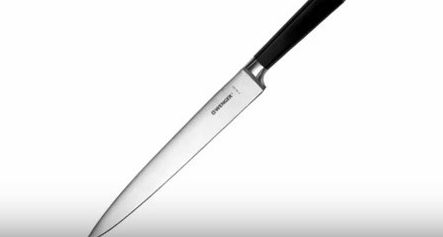
Advantages:
- can be used in the preparation of rolls and sushi;
- original blade shape;
- convenient;
- easy to clean;
- acute;
- lasting;
- flexible;
- keeps sharpening.
Disadvantages:
- some types are susceptible to corrosion;
- not multifunctional.
Average price:
- from 56 rubles. for a fillet knife 15 cm long, made by Daniks -
- up to 24,370 rubles, 24 cm long, made by Samura.
Best Manufacturer According to Buyers: BergHOFF.
For carving
Carving is a special art of figured carving from vegetables, fruits and sweets. It is interesting to learn the skill of decorating dishes or creating gifts in the form of an exotic, originally made edible bouquet, a spectacular composition, a small edible figurine.

There are whole sets that include everything you need to create food finesse: recesses for cores, egg cutters, different knives, small scissors, Parisian spoons, nozzles for pastry syringes, zest removers, baking tins, etc.
For beginners, acquaintance with this art, a special Thai curly knife will help.
The shape of the blade is crescent, curved towards the end. Various widths, short, with a sharp tip, it is the most important. He can perform most of the culinary operations.
Made of high quality stainless steel, it will not react with food or food acids.
It is important that the handle does not slip when working. The best option would be metal in combination with rubber inserts. It is hygienic and practical.
Advantages:
- multifunctional when decorating dishes;
- practical;
- takes up little space;
- anti-corrosion;
- acute.
Disadvantages:
- requires training before use;
- not performing all tasks efficiently;
- traumatic due to the sharp shape of the blade.
As you become more comfortable with carving, you can use other types of cutters to get the best quality culinary masterpiece:
- in the form of a small scoop for cutting out spherical shapes from the pulp;
- with rings at the end for peeling citrus fruits and creating stripes;
- in the form of a fork with a sharp end for the design of embossed grooves on the surface and obtaining shavings;
- wide, with an undulating plane for creating relief on the cut or skin.
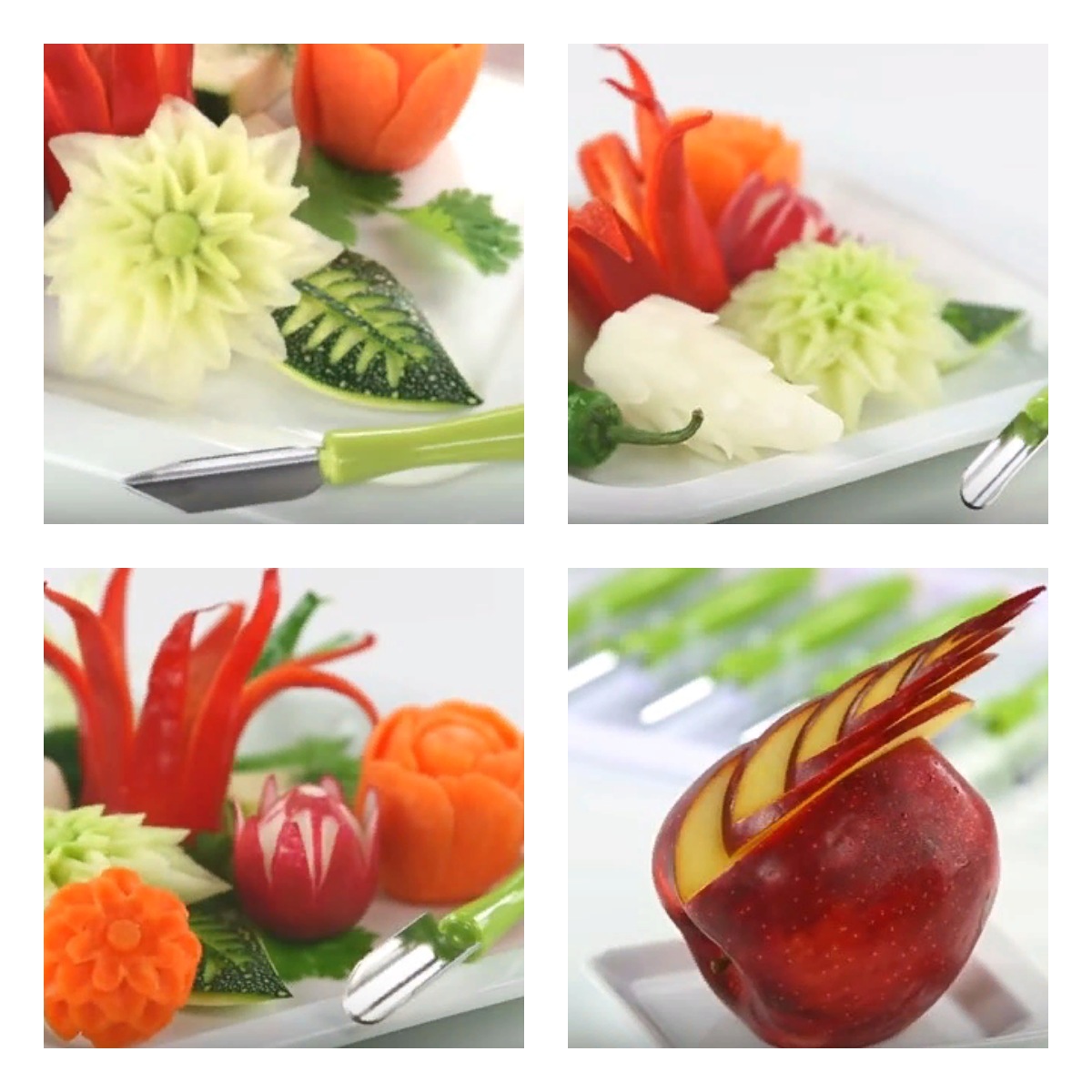
average price:
- From 62 rub. for a 13 cm long carving knife, made by ProHotel; RUB 95 for a set of 3 items -
- up to RUB 3900 for a set of 80 items, in a suitcase.
For pizza
Lovers of Italian cuisine, in particular pizza, should purchase a pizza cutter. Its classic version is disk.
It is made in the form of a handle (of different lengths) and a rotating disc at the end (also of different diameters). The optimal size of which is 7 cm, and select the handle based on the convenience when holding.
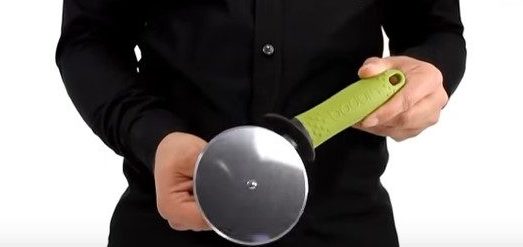
The most durable material will be stainless steel. The slicing of the cake occurs in the form of a rolling motion.
These pizza cutters are presented in two types:
- open - with a disc on the surface;
- closed - the cutting surface is partially contained in a suitably shaped case.
Choose the size of the disc, based on your preference for pizza (thick or thin).

Advantages:
- cutting neat and even portions;
- acute;
- multifunctional for similar products;
- lasting;
- easy to care for;
- moisture resistant;
- products do not stick.
- anti-corrosion.
Disadvantages:
- difficulties with sharpening;
- difficulty in cleansing
There are also various models for every taste:
- in the shape of a crescent;
- with laser pointer for more accurate portion marking;
- folding options;
- in the form of circles of various diameters with cutting planes located inside;
- in the form of scissors;
- design options in the form of a monkey on a wheel, a two-wheeled bicycle, a snail, etc.
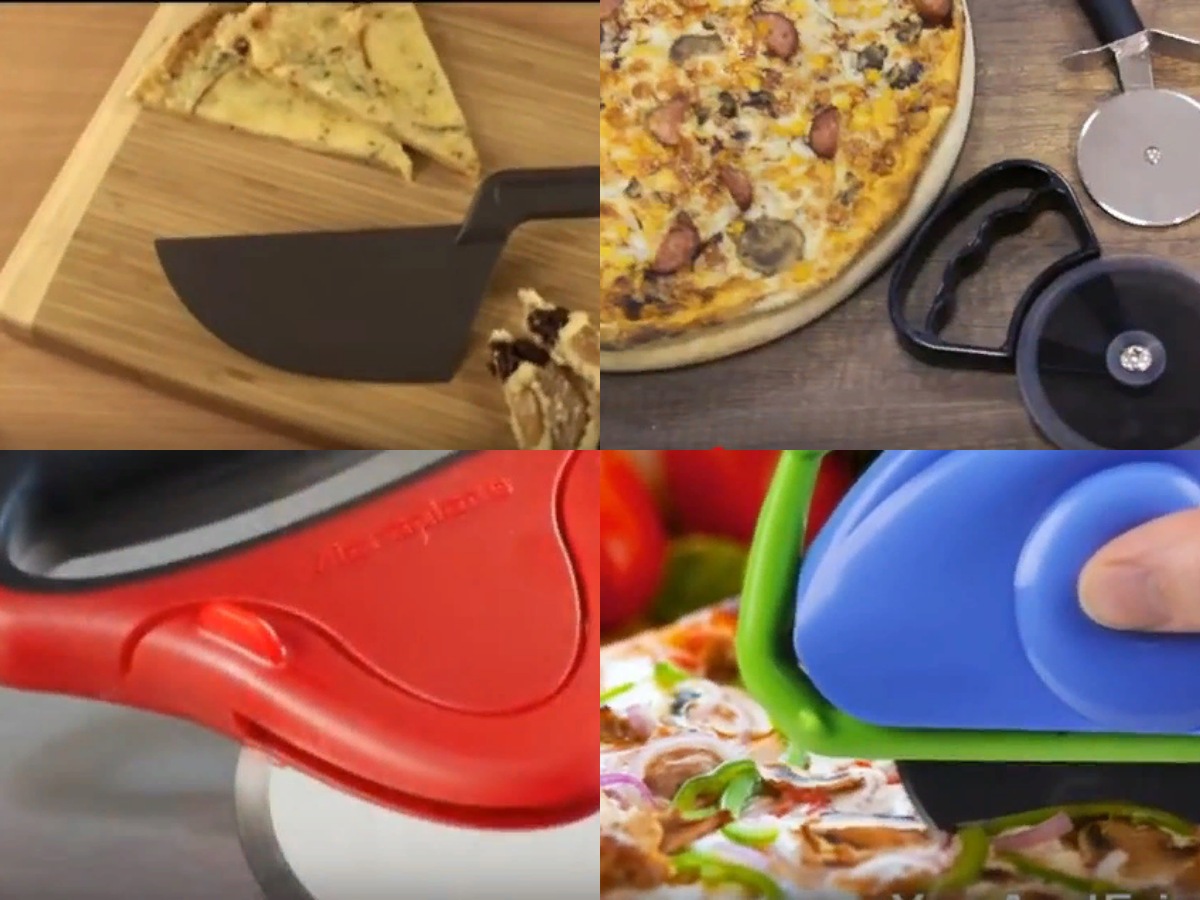
average price:
- from 69 rub. for a disc pizza cutter, 17 cm high -
- up to 2870 rubles, steel version, made by Fissler.
For cutting meat
Butchering beef, pork, lamb, chicken carcasses, large fish involves different stages, so different tools will be needed, in accordance with the kitchen operation.
For the initial cutting of a whole piece with bones, a chef's hatchet is suitable.
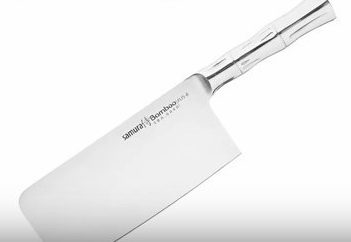
Rectangular in shape, large, very strong and heavy, with a thickened edge at the tip. These properties facilitate the initial cutting process.
It has to withstand the heaviest loads of any kitchen work in existence. It will be needed with moisture resistant qualities, safe to use, with a comfortable handle that does not slip out of the palm.
Made of titanium, damask, high quality carbon steel. The sizes are quite different.
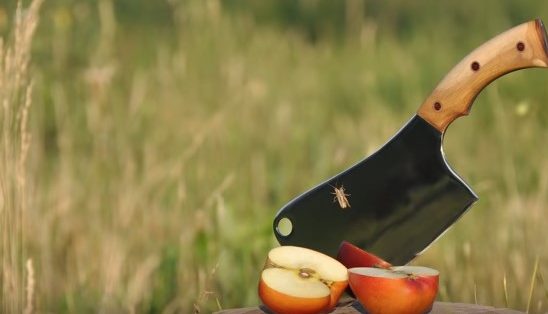
Advantages:
- copes with complex cutting options;
- suitable for different processes;
- anti-corrosion;
- lasting;
- acute;
- wear-resistant;
- easy to clean.
Disadvantages:
- may darken with poor cleaning;
- takes up a lot of space;
- requires careful maintenance.
For the subsequent stages in cutting, you can use sirloin, universal, chef's knife, santoku, depending on the process.
average price:
- From 223 rub. for a chef's hatchet knife, 19 cm long, made by Webber -
- up to 14,780 rubles, 15 cm long, made by Zwilling J.A. Henckels.
The best manufacturers according to buyers:
- VICTORINOX;
- Fissman;
- POLIVOOD.
For fish
Butchering fish consists of cutting the belly, cleaning the entrails, getting rid of the head and fins, slicing and filleting.
The fish knife should be 1.5–2 times larger than the cut product. Odorless, high strength, medium flexibility. Hygienic, because poor cleaning can lead to the development of germs.
With a total size of 13 cm to 30 cm, the optimal length is about 20 cm. Good sharpening is important for cutting bones. An important choice is a comfortable, good grip that will be easy to clean of fish waste and will not absorb odors.
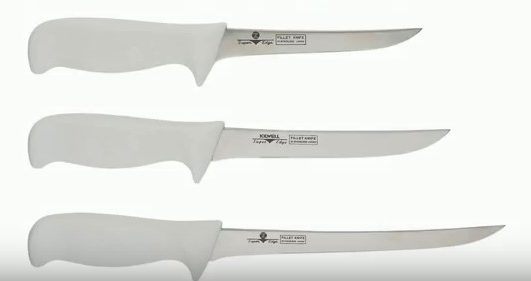
Advantages:
- hygienic;
- lasting;
- anti-corrosion;
- keeps sharpening;
- does not absorb odor.
Disadvantages:
- not multifunctional;
- requires careful maintenance.
For frozen food
A special knife is required for frozen or semi-thawed food. A sawtooth shape that will support the load and cut the frozen mass and bones. Made of hardened steel, high performance.
The comfortable handle is usually larger than a long blade with a serrated fine sharpening. There may be a forked bifurcation at the tip.
Slicing with it will turn out to be smooth and thin. And not only frozen products, but also bakery products, vegetables, etc.
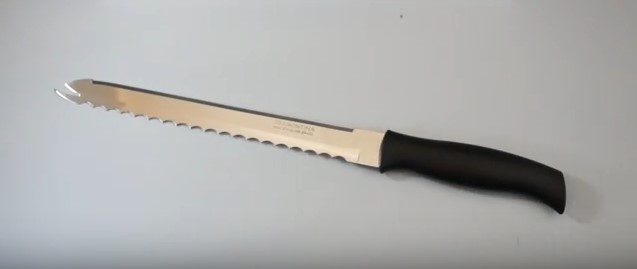
Advantages:
- heat resistant;
- multifunctional;
- lasting;
- hygienic;
- easy to clean;
- acute.
Disadvantages:
- impossibility of sharpening at home.
Top manufacturers
Now that we have got acquainted with the main models and their characteristics, let's look at which knife companies you should pay attention to.
- Japan - Yanagiba, Deba, Usuba, Demo, Masahiro, Tojiro, Mikadzo, Globall, Kai, Samura, Kiosera;
- Germany - Rondell, Wusthof, Fissler, Zwilling J.A. Henkels, BergHOFF;
- Brazil - Tramantina;
- Switzerland - VICTORINOX;
- Sweden - Eka, Frost;
- Italy - Delben;
- Spain - Arcos;
- Finland - Fiskars;
- USA - KithenAid;
- France - Savate;
- Russia - TimA; master Prokopenkov.
Vendors offering high performance private label products, quality custom made in China.
The best ratio of price and quality:
- VICTORINOX;
- Arcos;
- Tramantino.
Top quality knives rating
Below are the ratings of the best models by popularity, quality, brand.
Popular brands:
- Samura;
- Rondell;
- Mayer & BOCH;
- Nadoba;
- TEFAL;
- Fackelmann;
- Tojiro;
- Gipfel;
- Teskoma.
Models of quality products of various brands at a price:
- Kai - 275,000 - 135,000 rubles;
- De Buyer - 132,000 rubles;
- Laguiole - RUB 85,900;
- Buck Ranger - 67 900 rubles;
- Hiroo ltou - 52,500 - 49,500 rubles;
- OPINEL - 48 600 - 45 000 rubles;
- Extrema Ratio - 44,200 rubles;
- VICTORINOX - 41,000 rubles;
- Extrema Ratio - 40 500 rubles.
It is up to you to decide how many knives will be in your home arsenal, but their quality must be at the highest level so that culinary creativity does not turn into a kitchen battle. A joint work brought joy without turning into a real medieval torture.
We hope that this article on the best kitchen knives of 2020 has become useful and informative for you. If you have experience using the kitchen knives described in the rating, or a more interesting model, tell us about it in the comments.




